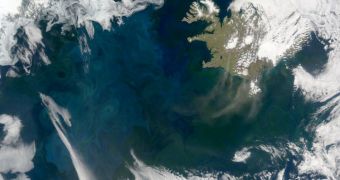Across the Atlantic Ocean, microscopic organisms called phytoplankton are blooming, coloring the waves, and revealing intricate patches when seen from satellites. Thanks to support from the National Science Foundation, experts have recently been able to figure out why the blooms are so extensive now.
The phenomenon represents a sort of spring and summer ritual for the oceans. These organisms are of critical importance for the entire planet. In addition to forming the basis of the oceanic food web, they also contribute extensively to the ocean's ability to soak up carbon dioxide from the atmosphere.
The North Atlantic Bloom is by far the largest and most spectacular of them all. The formation is constantly changing color, depending on which species of microorganisms becomes dominant, or enters full bloom.
In the new study, details of which appear in the current issue of the top journal Science, scientists pinpoint the factors that led to such an impressive development of phytoplankton. Apparently, eddies that exist in the water support the organisms at the surface, preventing them from submerging.
This, in turn, allows phytoplankton to receive a lot of sunlight for photosynthesis. Given that there is more than enough carbon dioxide in the atmosphere to fuel their growth, the organisms will simply continue growing until there are no more resources for them to consume.
Such huge blooms can have effects on the global carbon cycle, experts at the University of Washington and the University of Maine say. Phytoplankton can consume very large amounts of carbon dioxide from the atmosphere.
Usually, after filling up on the chemical, the microorganisms die and fall to the ocean floor, where they store global warming-producing carbon for millions of years. They also contribute to ocean acidification, since some of the carbon combines with water to create carbonic acid.
As they consume CO2, the blooms release large amounts of oxygen. During a regular year, such blooms allow the world's oceans to remove up to 33 percent of the entire amount of carbon that humans put into the atmosphere through the burning of fossil fuels.
The North Atlantic Ocean alone consumes around 20 percent of the carbon that global phytoplankton blooms use up. As the planet's climate changes, the patterns in which phytoplankton consumes CO2 are expected to shift as well. Exactly how this process will influence the carbon cycle is still unknown.
“Our results show that the bloom starts through eddies, even before the Sun begins to warm the ocean,” explains Woods Hole Oceanographic Institution (WHOI) oceanographer Amala Mahadevan, the lead author of the Science paper.

 14 DAY TRIAL //
14 DAY TRIAL //